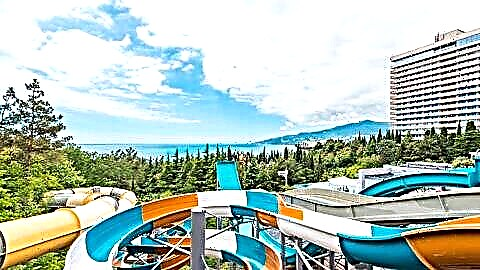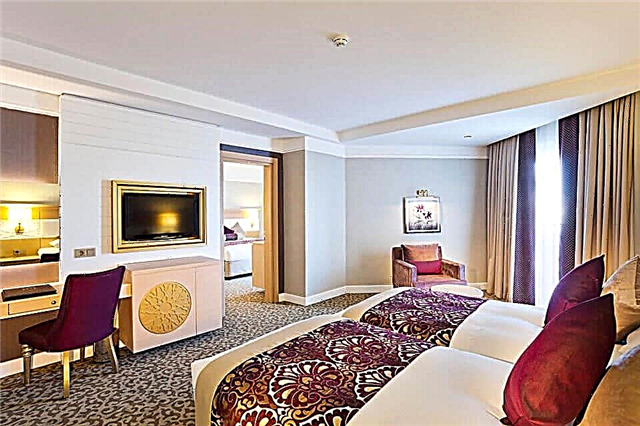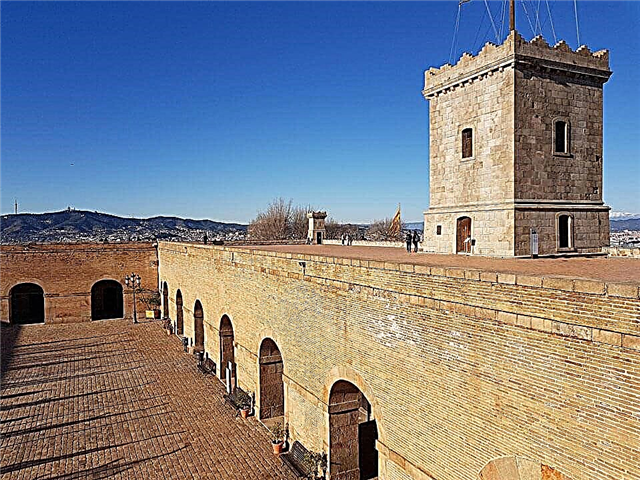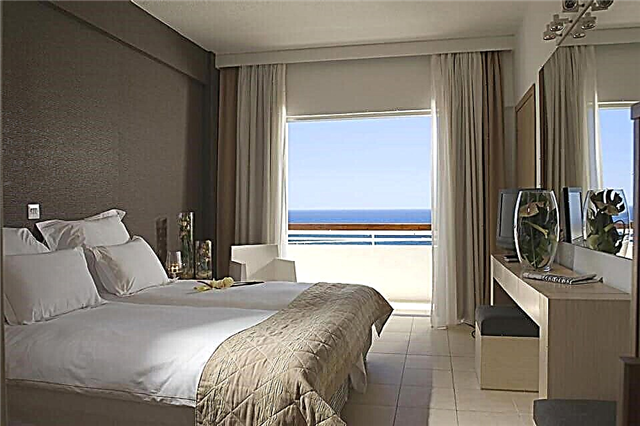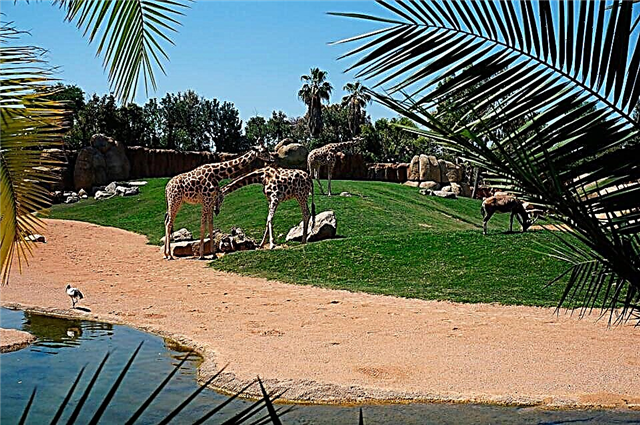A trip to the capital of Catalonia, the city founded (according to ancient legends) by Hercules, is not only long-awaited, mysterious, but also requires special preparation. To get acquainted with its history, see at least a piece of sights is offered in a variety of excursion routes. By paying for the services, you can feel the extraordinary atmosphere of the premises of the Main Royal Palace, where the kings of Catalonia solemnly greeted Columbus. Enter numerous churches, Cathedrals, the Town Hall building. Get acquainted with the "heart" of the city - the ensemble of buildings of the Gothic quarter. Freeze with amazement, looking at the architecture of Antoni Gaudi, visit museums, art galleries, theaters. Famous artists and sculptors created their masterpieces in the amazingly beautiful city. Some of them can be seen using Barcelona's free entertainment. This helps to significantly save travel budgets without compromising the quality of your Barcelona experience.
Citadel Park

In the central part of the city there is one of the favorite places for recreation of residents, for walking for guests. Its appearance is associated with the historical period of the 18th century, the construction of powerful walls of the fortress. Later, thanks to the efforts of famous architects, the park was decorated with fountains, sculptures, flower beds, alleys. Part of the city has turned into a luxurious recreation area, harmoniously complementing its extraordinary atmosphere. It is nice to walk here with children, just relax on the shore of the lake.
See the huge fountain "Cascade", made in the form of the Arc de Triomphe and unique sculptures of Venus, Aurora, mythical animals. The zoological museum (Castle of the Three Dragons), the zoo (here you need to pay for the entrance ticket) are of great interest to children. It ranks among the best zoos in Europe. For free in the park, you are invited to walk along the famous promenade - Companias Alley.
See the buildings of the old chapel, the governor's palace, the arsenal. It is proposed to start exploring the Park from the location of the Arc de Triomphe of the city. It is located at the beginning of Kompanias Avenue. It's easy to get here by metro L4. Get off at the Ciutadella / Vila Olimpica station. Take tram 4 to the Wellington stop.
Barceloneta beach

The oldest beach in the city is a 15-minute walk from the famous Columbus monument. A wide coastal strip of golden sand (1.1 km long) has appeared on the site of an old fishing village. The area of the city changed in preparation for the 1992 Olympics. The beach infrastructure was formed here, the buildings of hotels, cafes and restaurants appeared. The embankment is equipped for unhurried walks along the seashore. Areas for roller-skating fans have been allocated.
Sports, playgrounds and play areas are guarded by the police around the clock. The free beach is considered the safest, most protected recreation area and a favorite among local youth and tourists. The beach area near the Olympic port ends. Not far away you can see interesting ships, the tallest skyscrapers of the city. Their height is 154 m. For a small fee, walks on some ships are allowed. You can come to the beach by metro (there are several stops nearby), by ground transport.
Metronome Museum

In 1980, one of the city's modern museums began to work in the building of an empty wholesale warehouse. The initiator of the creation was the collector Rafael Tous. A feature of the exhibitions of the new institution is an innovative form of presentation of elements. The Metronome Museum has become a platform for the expression of new, unexpected ideas, experiments by masters of different directions of art and creativity.
Among the interesting expositions are sculptures, paintings, photographs, video films, original works of national culture. In some places, modern and forgotten dances and music are presented. Acquaintance with exhibits of experimental art takes place using installations and other techniques of the new era. Exhibition offers are often difficult to attribute to a specific art form. Combined in one place, they are original and make it possible to call the ensemble the Museum of the Future.
Exhibitions built with the use of modern technologies are offered to be viewed without paying an entrance ticket. There are many such museums in Barcelona, which allows you to learn interesting facts from the culture of the country even during a short trip. Who knows, maybe among the innovative works are the works of the future Dali, Gaudi, Picasso. The temperament of the Catalans, the sea, the sun, the mythical past have always shaped great abilities in art here. Address: Carrer de la Fusina, 9.
Mount Montjuic

One of the best places for free travel is the sightseeing of Montjuïc Mountain. An excellent view of the city and the Mediterranean Sea opens from its top. Climbing the hill with a height of 170 m, it is recommended to start from the Plaza de España. Structures of the ancient land (bastions, watchtowers of the famous fortress, erected in 1640), guarded the capital of Catalonia and were considered strategic objects.
In the XX century, "Jewish Mountain" or "Hill of Jupiter" received a rebirth: it became the largest European park. Next to the architectural masterpieces of the Middle Ages (the castle at the top, the Spanish Village), new buildings of museums and the Olympic Center have been erected. Events in honor of the World Exhibition in 1929, the 1992 Olympic Games put in order the green kingdom, created huge botanical gardens (their area is 300 hectares) with walking paths, cozy recreation areas, exhibition grounds, theaters.
Among the attractions on the mountain, tourists are attracted by: the main historical building, the Montjuic Fortress, the Magic Fountain, the futuristic Calatrava Tower (television tower). Designed by Santiago Calatrava, the striking steel structure looks like an athlete holding an Olympic torch. The time is determined by the shadow from its spire, as by a sundial. The ancient breath of life is felt most strongly during a trip to the old cemetery, opened in 1883. Columbarium, sculptures, monuments, Gothic monuments do not stand out against the background of modern buildings, but create a harmonious historical ensemble. You can walk here all day.
Magic fountains

At the foot of Montjuïc mountain, against the backdrop of the majestic Palau Nacional National Palace, there is a light and music, magic fountain Font màgica de Montjuïc. Millions of tourists come to admire the spectacle formed by the unusual hydrotechnical structure. It is difficult to convey the feelings of a person, when in the evenings over 3 thousand jets of water fly up simultaneously with music and merge in a single dance, intertwine with each other.
At the same time, the palace looks even more mysterious, more beautiful. The magic effect of the fountain is created by the passage of high pressure water through special filters made of cermet. The fountain illumination is constructed from 4760 radiation sources with 50 shades. The fountain is supplied with water by five pumps and 2629 separate streams. They are controlled using computer programs. The equipment is located in the machine room. It is located under the center of the fountain. You can go to him. The main fountain is surrounded by oval basins built in the form of steps.
The total volume of water in them is 3 million liters. The height of the fountain streams reaches 50 m. The magic fountain is part of the ensemble of cascading fountains located from the National Palace to the Plaza de España. A unique show of light and music takes place in the evenings (seasonal schedule applies) and lasts about 3 hours for 20 minutes. Classic, folk, popular melodies are heard over the square. Water jets dance to the beat of the music. It is best to observe the bizarre figures while sitting on the steps of the palace.It is proposed to get to the magic fountain by bus 150, 13, metro.
Museum of National Art

For the opening of the exhibition in 1929, the Palau Nacional was built. The building, designed by the architect Pedro Kendoya Oskoe, housed the Electricity Pavilion. In 1990, the building was restored and transferred to the Museum. The first collections were formed on the basis of elements of the existing institutions of Contemporary Art and the Museum of Art of Catalonia. Now the composition has been supplemented with three cultural institutions. Since 1932, the Museum (the premises of the palace) has been hosting exhibitions of paintings, sculptures, and various objects of art.
The museum is considered to be the center of the collection of works from the Romanesque period. It contains many artistic masterpieces created during the Renaissance, works with elements of Gothic, Baroque, Catalan easel painting. They are presented by independent expositions. The department of contemporary art of Catalonia was opened with paintings of modern art from the 19th and 20th centuries. A separate room is dedicated to exhibitions of prints and drawings. These are the best works created in the last three centuries.
Moments from the past are reflected in a large collection of photographs. Explainable interest is aroused by the examination of the expositions of the numismatics department. Shown here are coins from the 6th century BC. The Museum houses restoration workshops and a library. The entrance ticket is valid for 2 days from the date of purchase. Its cost is specified on the website. To visit the Museum free of charge, you must arrive on the first Sunday of every month. Children under 15 years old, adults over 65 years old pass without payment on any day.
Park Guell

It's impossible to come to Barcelona and not walk through Park Guell. Its story was born in 1900 according to the idea of the richest man of those times, Eusebi Güell. He proposed to create a garden city on Bald Mountain, which can only be seen in a dream. He invited his friend Antoni Gaudi for the work. His unusual understanding of the world, the idea that "there are no straight lines in nature, it is never one-color" made it possible to build a monument of unlimited imagination, unpredictable architectural solutions.
It is difficult to determine where the elements of architectural styles end, the possession of masterpieces of sculpture, volumetric painting begins. Amazing buildings, hilly pavilions, caves, grottoes, figures of fantastic animals associated with the legends of the appearance of Barcelona, palms made of stone that look like living ones. In 1984, Park Guell was included in the UNESCO heritage lists. Since 2015, a visit to the park has become paid. There is only one option (useful and not bad) to walk along the amazing paths, sit on the famous bench or stairs, think while looking at the houses built by Gaudí without buying a ticket.
This is to go to the monumental area before the opening starts. There is an approved opening hours for the park according to winter and summer schedules. At any other time, the safety ribbons are removed, providing access to free space. After analyzing your capabilities, you are invited to safely go for a walk. Twilight and darkness will not be complete, and the fairy tale looks even more real. Better yet, visit the park with a pre-ordered ticket (the main thing is not to be late by the specified time) and take a walk several times in the evening or at dawn (work starts at 8, 8, 30 am). Park address: Carrer d'Olot, 13.
Boqueria market

Visiting the market can be conventionally called free. You don't have to pay to enter the Sant Josep market, but any wallet will become easier after walking through the popular grocery market. The first mention of the colorful market dates back to 1217. Not far from the entrance gates of the city of Bokeria, they set up shops and sold meat. In 1470 it was called the "Straw Market" (Mercat de la Palla), they sold pigs and any goods. Now it is a glass and concrete building, decorated with beautiful mosaics.
The metal roof appeared in 1914. There are many sales areas and the necessary equipment. The multi-tiered counters are lined with aromatic meat and fish dishes. They are always fresh, the assortment is made up of products brought from different regions of the country. The best place to taste the famous jamon meat ("pata negro") is here. And also you cannot pass by the multi-colored tables with fruits, enjoy their extraordinary aroma and, of course, taste the fruits of the Mediterranean paradise.
The authentic atmosphere of the old market entices, gives pleasure from the "free" walk. To make a purchase correctly, it is recommended to visit the market several times. At the first impression, the eyes cannot stop at something concrete and necessary. Market address: Placa de la Boqueria. The nearest metro station is called Liceu. Starts working at 7, 8 in the morning. The best time to visit is considered to be from 6 to 7 pm.
Sagrada Familia
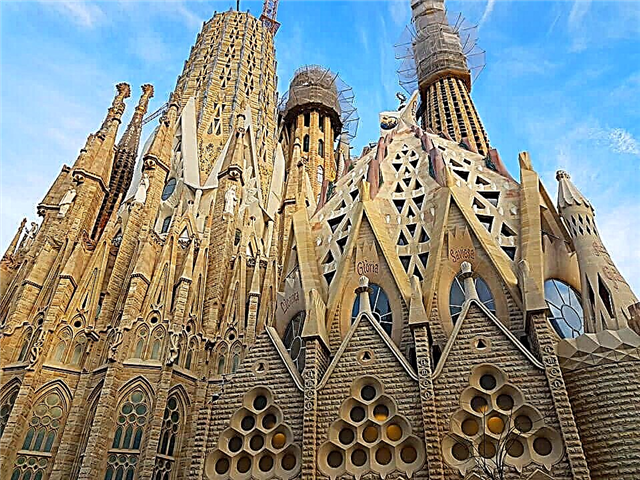
The temple is considered the most famous landmark. This is the redemptive church. From the point of view of Catholics, it is intended to atone for the sins of unbelief committed by the inhabitants of the city over the past two centuries. The construction of the church was carried out at the expense of donations. It is invited to see it from the inside and outside. Impressions will remain unique. As if a stone lace, created by an unknown force, descended from heaven, froze and aspires to the sky, the sun.
The long-term construction of the planet has an amazing history associated with the work of Gaudi. After the tragic death, construction continues according to the drawings developed by the author. It was his fantasy, an unusual perception of the world that gave descendants a magical stone fairy tale. The stone arms of the powerful columns with capitals resembling tree branches reliably hold the structure, similar to the cobweb of the trunks of a wild natural forest.
Unusual engineering solutions of the architect, their full compliance with the laws of mechanics have been confirmed in our computer age. The consecration of the Temple took place on November 7, 2010. It is planned to complete the construction of the Temple in 2026. And then the highest Christian church on the planet (172 m high) will appear before the eyes of surprised tourists. Now this place is occupied by the Ulm Cathedral in Germany. The Gothic towers of three facades (under Gaudí, one facade of the Nativity was erected) will indeed “sing” from the wind, as an “organ for the Lord,” filling the Temple with the music of the Creator.
Mount Tibidabo

Standing on the observation deck at the feet of the Christ figure crowning the amazing Gothic Church of the Sacred Heart, one cannot help but feel the spirit of the legends of the birth of Barcelona. Moreover, it is visible from anywhere in the city and attracts people with fantastic power. Here is a magical world created by God as an invaluable gift to humanity. "Tibi Dabo" or "I give you" the devil whispered to Christ, offering to give all earthly joys. Christ did not betray a person, and as a token of gratitude, people erected a temple, striving to heaven, to the triumph of light, victory, and the sun.
Historians have proved that there was a monastery in the holy place long before the construction of the Temple. The aura of antiquity did not disappear, but entered the atmosphere of the Holy Temple. You are invited to come to the panoramic platform on the famous blue tram. The ascent to a height of 575 m takes place over steep slopes, green massifs, gorges and makes a special impression on the trip. It is proposed to spend the whole day on the mountain (grabbing food, since there are few restaurants, cafes). The trip is of particular interest to children.
They can see the ancient luna park with numerous attractions. This is "Air Train", "Airplane Tibidabo". During an extreme flight, the entire city is clearly visible. Despite their venerable age and pristine appearance, the rides are safe and comfortable. On the territory there is a Museum of Mechanical Toys, Robots, a Viking carousel, a Ferris wheel. The park was formed at a time when the mountain was not included in the city. The extraordinary panorama from the mountain will remain in your memory for a lifetime.
Rambla street

The pedestrian street of the city of the central part starts at Plaza Catalunya and goes to the Old Port.Structurally, it consists of 5 independent boulevards, connected into a single zone 1.2 km long. The spacious promenade on the seashore forms the bustling atmosphere of the city center and a popular promenade bordered by interesting sights. There are always a lot of people walking here. They look at the pearls of Catalan architecture: the Liceo Theater, the Boqueria market, the Virreina Palace.
They visit museums of wax figures, erotica. Near the street is the famous Gothic Quarter, the building of the city's oldest university. There are many boutiques, restaurants, cafes, souvenir shops, and other elements of the tourist infrastructure on the ground floors of houses standing on the street. Useful information for those wishing to make purchases: the biggest discounts (up to 70%) appear in August and January.
The promenade is buried in flower beds, beautiful alleys. There are original "living" statues on it, there is a cheerful bird market. At the end of the boulevard, the waves of the Mediterranean Sea are lapping. The most beautiful street is often called the heart of the city. Near Plaza Catalunya (Rambla or Canaletes) there is a famous cast-iron fountain made in the 19th century. Tourists rush to drink water from it to test the belief and be sure to come to Barcelona again.
Orth's Labyrinth

On the territory of the old estate Desvalls, located on the slope of the Sierra de Collserola mountains, a neoclassical garden appeared in the 18th century, which became the oldest park in the city. The main part of the park (which gave it its name) is a maze of cypress trees. On an area of 50 by 50 m, intricate paths are formed, fenced with slender plantings. It seems that it is easy to walk through them. But you don't even notice how you find yourself in a green dead end.
From this moment, an exciting game of victory over the maze begins. Crowds of tourists are trying to fall into this place. In the central point of the labyrinth there is a platform with benches for rest. Having gained new strength, visitors find a way out. The park consists of several levels, a romantic garden. There are many beautiful flower beds in it. The pleasant streams of the waterfall are ringing. Above the labyrinth there are pavilions made in the spirit of Spanish traditions.
Tuscan columns, statues of Ariadne, Danae, copies of ancient Roman temples. Near the stairs leading to the last tier, there is a statue of the god of winemaking Dionysus. On the upper part there is an interesting pavilion dedicated to nine muses and a beautiful pond with water from an underground source. Address: st. Passeig dels Castanyers? 1-17. It is proposed to go by metro to Mundet station or by bus routes 76, 73, 27, 60.
Bunker El Carmel

To see the beauty of Barcelona, tourists use the equipped observation decks. There are many of them in the city. Among the best places is the observation area, located in the historical landmark of the city - Bunker El Carmel. It was built in 1947 during the civil war on the summit of Mount Turo de la Rovira. The view from the bunker towers was 360 degrees. It was the most convenient spot to watch the approaching enemy.
Preserved walls, loopholes of two towers used for shelling. They can be bypassed, examined in detail. From the observation deck, you can see the streets of the nearby Eixample district, running beyond the horizon. Port, endless sea, Mount Tibidao, Park Guell, Church of the Virgin of Carmen. The city lies very close. The bunker is located at Marià Lavernia, 59. The easiest way to get here is by bus # 119 from the Panorama-Labèrnia stop. But you can take the metro or walk. Enjoy the panorama of the city free of charge.
Plaza Catalunya

In this place it is convenient to start an independent (and together with organized excursions) acquaintance with the city. On the central square there are stops of many transport routes, tourist buses, four metro lines intersect. 9 famous streets start from the square, including the famous pedestrian Ramblas. Until the middle of the 19th century, there was a wasteland, separated from the city by a wall.
According to the project of Ildefonso Cerda, the territory began to be built up with buildings of the neoclassical and historicism style. 28 sculptural compositions made by famous masters were placed on the round square. An open-air sculpture museum was formed. It includes graceful statues "Youth", "Goddess". Complex works "Work", "Wisdom", "Shepherd", figures of horses. Tourists are interested in the monument to the first president of Catalonia in the form of an inverted staircase, fixed on a pedestal of stone.
Each of the four provinces of Catalonia is represented by its own sculptural group. Beautiful flower gardens, numerous fountains with drinking water, a green lawn surround the square, creating a natural oasis in the heart of the bustling city. Residents hold festivities and concerts on the square. Tourists are happy to get acquainted with the architectural masterpieces that surround the square.
Among them are the Pech i Pon house, owned by the Credit Bank of the country, the Huge El Corte Inglés store with unlimited quantities of any goods and a panoramic restaurant. Triangle shopping center, Zurich cafe. It is proposed to come to the cult place of the capital (north - western part) by metro to Catalunya station.
Las Arenas

Walking around the Plaza de España, one cannot but visit the huge shopping center. The history of the building is connected with the famous bullfights that took place here in a special arena. The ban on their holding in 2012 demanded to change the purpose of the building. The six-storey building houses 100 shops, a cinema, a spa center, a hairdresser, bars, cafes and restaurants. Shopping lovers are offered a selection of Punto Roma Desigual Mango Celio branded products.
Cosmetics, sports uniforms and equipment, household appliances, children's toys, clothing. The ground floor is like a market with a lot of eateries. On the top floor there is the main feature of the shopping center - the observation deck. It is offered to come to the open terrace by a paid elevator, or free of charge by an escalator from the sales areas.
Restaurants are located around the terrace. There are 10 of them. Each menu includes different options for meals. Fast food, sushi, tapas, grilled meats according to traditional Catalan recipes, masterpieces of Japanese cuisine, etc. Sitting in any of the restaurants, you can enjoy the view of the city, the extraordinary sunset. Shopping center address: Gran Via de les Cortes Catalans, 373 - 385.
Flea Market Encants

Most often, a place is allocated for flea markets in a vacant lot closest to a large city. Lovers of antiques, old spare parts for various equipment, clocks, cameras, etc. are drawn here. It is a pleasure for them to check mountains of old things in search of something interesting for themselves. Moreover, the price can always be negotiated.
The history of the creation of such Encants market begins in the XIV century. It is considered the oldest flea market in Europe. Several years ago, a specific trade center was occupied by an ultra-modern building, built using new materials and technologies. Convenient location near the metro Glories attracts locals and tourists here. The market stalls are filled with antique jewelry, lace capes, shawls, and porcelain items.
Black and white photographs that adorn many counters create a special atmosphere of bygone times. The building's mirrored ceiling multiplies an endless paradise of interesting goods. It is recommended to come here early in the morning. The chances of finding an antique silver tray, a vintage leather product, an inimitable watch, or a picture are greatly increased.



